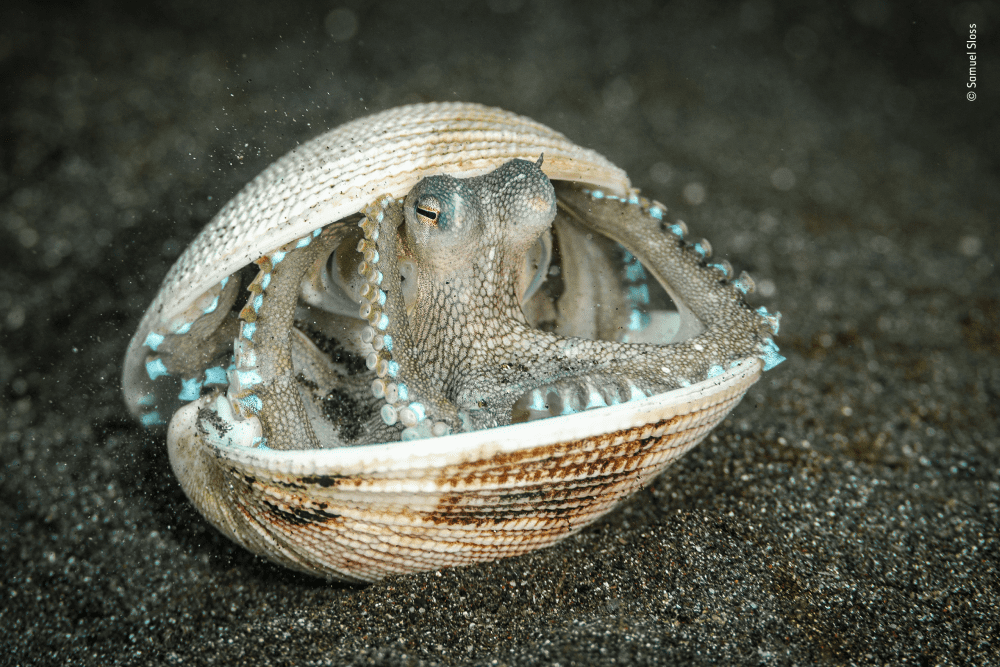The Natural History Museum, London’s Wildlife Photographer Of The Year Competition 2022 is on the horizon, and boy, do we have a treat for you. Now in its 58th year, the competition has released some of the highly commended images to feature in this year’s exhibition, and there are some beauties, let us tell you.
From octopuses hiding in shells to dipper disputes and a tense showdown between a dog and a sloth, this first sneak peek at the photos in store is already living up to the competition’s reputation for delivering images of the natural world that are as arresting as they are humorous. So, let’s take a peek at what we have so far.
Polar Frame (above) by Dmitry Kokh, taken in Kolyuchin Island, Chukotka, Russia.
Dmitry Kokh’s images of polar bears that had taken claim of an abandoned settlement went viral earlier this year, and it’s easy to see why. Kokh found the animals looking like they had the run of the place, which was abandoned by humans back in 1992.
There were over 20 animals in total that could be seen exploring the ghost town (viewed through the safety of binoculars). Kokh was able to zoom in for a closer look without risking starting a brawl with the aid of drone photography.
Coconut octopuses are famous for hiding in inanimate objects. Image credit: © Samuel Sloss, Wildlife Photographer of the Year
The Octopus Case by Samuel Sloss, taken in Lembeh Strait, Sulawesi, Indonesia.
This image was snapped by Samuel Sloss, who spotted a coconut octopus peering out of a shell suit. At first the octopus locked itself in as a defense against Sloss’s arrival, but eventually felt confident enough to get a look at was going on.
These animals are famous for hiding inside bits and bobs taken from its marine environment. Most notably coconut shells, hence the common name.
Quite the staring contest. Image credit: © Richard Robinson, Wildlife Photographer of the Year
The Right Look by Richard Robinson, taken in Port Ross, Auckland Island, New Zealand.
Whales are among the most intelligent animals on the planet and, as this photo shows, are capable of expressing curiosity with the most inquisitive of side-eyes. This young southern right whale, known as ‘tohorā’ in Māori, is a protected species having been almost hunted to extinction by European whalers in the 1800s.
Their numbers have since bounced back somewhat, recovering from a small group made up of just 13 breeding females to a considerably larger population of around 2,000 individuals.
Wildlife photography only ever gets harder when mosquitos are involved. Image credit:© Brandon Güell, Wildlife Photographer of the Year
Treefrog Pool Party by Brandon Güell, taken in Osa Peninsula, Puntarenas, Costa Rica.
If ever there was a party we’d like to crash, it would have to be this pool party. Brandon Güell was wading through murky waters when he came across the party revelers, a bunch of males emitting a chorus on the search for a mate.
Come dawn, long after the party had been crashed by a plague of mosquitos, Güell’s perseverance was rewarded as thousands of females responded to the call and came to lay their eggs. Such mass breeding events are rare and hard to come by but will give rise to huge clutches of eggs that will one day turn into tadpoles.
Fortunately this showdown was more of a “hello”. Image credit: © Suzi Eszterhas, Wildlife Photographer of the Year
Sloth Dilemma by Suzi Eszterhas, taken in Puerto Viejo de Talamanca, Costa Rica.
Slow moving sloths like this brown-throated individual have a hell of a task ahead of them when moving around urban areas, sometimes having to travel to the ground to connect disconnected bits of forest. Suzi Eszterhas was passing with her camera when she spotted this dog eying one trying to reach a clump of trees that was only accessible across the ground.
Fearful what the dog might do, Eszterhas was no doubt relieved when the dog, having been trained by the Sloth Conservation Foundation, simply sniffed it. Dog attacks are a big problem for sloths, but luckily this one came across a good boy.
Rocks are hot property for dippers. Image credit: © Heikki Nikki, Wildlife Photographer of the Year
Dipper Dispute by Heikki Nikki, taken in Kuusamo, North Ostrobothnia, Finland.
For dippers, rocks are very important. These platforms are their best position for spotting larvae and fish and launching their attack.
Being such hot property means that these dipping rocks can be a source for dispute, and after years of visiting this particular river Heikki Nikki knew which ones were most likely to host an argument. The knowledge meant he was in prime position when one such spat broke out, capturing these two birds mid-argument.
Hungry for more? Check out last year’s spectacular winners.
Source Link: Treefrog Pool Parties And Whale Side-Eye Among Wildlife Photographer Of The Year's Highly Commended Photos
